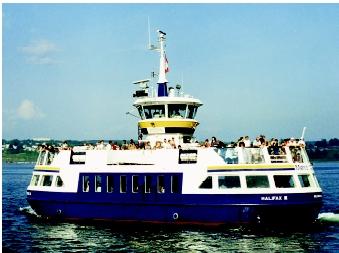Transportation
Historically, societies have always located near water, due partly to the fact that water enables more efficient travel compared to going over land. Waterways are critically important to the transportation of people and goods throughout the world. The complex network of connections between coastal ports, inland ports, rail, air, and truck routes forms a foundation of material economic wealth worldwide.
Within the United States, waterways have been developed and integrated into a world-class transportation system that has been instrumental in the country's economic development. Today, there are more than 17,700 kilometers of commercially important navigation channels in the lower 48 states.
Early History of Water-based Transportation
The historical development of water-based transportation is connected to the importance of domestic and international trade. Early exploration of North America identified large amounts of natural resources such as fisheries, timber, and furs. Trade centers were established along the east coast of North America where goods could be gathered together and ocean vessels could transport them to consumers in Europe and other foreign areas. The success of commercial trading companies spurred the introduction of

From the sixteenth to the eighteenth centuries, small subsistence farms were prevalent among the American colonies. Eventually larger farms emerged and produced crops such as wheat, tobacco, rice, indigo, and cotton that were commercially marketable in Europe. Ocean vessels transported the bulk, low-value goods from the colonies to Europe and returned with high-value, low-density goods such as inks, linens, and finished products that had a much higher return on the investment per vessel trip.
Agricultural production continued to grow and support the growing colonies' economic development. The speed and low cost of transporting goods by water influenced the locations of population settlements near navigable water (rivers, lakes, canals, and oceans). Goods produced on inland farms were transported via inland waterways to the coastal ports. Goods shipped by smaller vessels from surrounding ports were transported to New York, Boston, and Philadelphia, and exported on larger oceangoing ships. These ships from the smaller ports then transported imported goods back to the surrounding ports.
During the 1700s, the British government passed many acts, such as the Navigation Acts and the Stamp Act of 1765, designed to collect taxes from the colonists. The acts affected trade, and were met with opposition from the colonist. In Philadelphia during the fall of 1774, the "Declarations and Resolves of the First Continental Congress" called for non-importation of British goods, and became a catalyst for the American Revolutionary War (1775–1784). The resulting independence for the United States allowed trade a free rein, and it flourished.
Westward Expansion.
The westward expansion of the United States exposed a wealth of natural resources and an increased production in agricultural goods. The inland transportation infrastructure of roads, railroads, canals, and rivers connected the early western settlers with the rest of the nation, and enabled goods to move from the west back to more populated areas in the east and onto other parts of the world. The River and Harbor (Appropriations) Act of 1876 established federal funding of waterways to promote national commerce but not to benefit any particular state nor to allow waterway tolls.
Twentieth and Twenty-First Centuries
Increased levels of world trade resulted from the economic growth occurring since the end of World War II in 1945. The United States was in the position to take advantage of new trading opportunities as new world markets opened. Developing countries demanded capital goods, agricultural products, consumer goods, and commercial services, which the United States could provide. As these nations produced goods for export, the United States became a market for these goods.
A significant factor in the opening of the inland waterway system (and the resultant world trade superiority of the United States) was the advances in ship technology and the application of steam power to ships that traveled the extensive water network. Larger and faster ships emerged from the advances in ship and engine design and improvements in construction materials.
Methods of cargo handling evolved to keep pace with the larger vessel sizes. The introduction of palletization and roll-on/roll-off cargoes enabled vessels to be loaded and unloaded in less time. The emergence of containerization in the late 1950s dramatically affected the shipping industry and port infrastructure. The increasing size of containerized cargo vessels became a driving force in the demand for expanded ports and improved facilities.
Importance to Foreign Trade.
Transporting goods with foreign trading partners can be accomplished by road, water, rail, or air. However, for the

About 95 percent of U.S. foreign trade passes through its port system. Ports function as the transfer point between land and water transportation of cargo. * For vessels to transport the foreign traded cargo, they must be able to access the ports through established channels. The channels provide adequate water depths for the vessels and navigational aids.
Today's Global Trade.
Today the world economy has become globalized. The economic system is changing from one with distinct local and national markets, separated by trade barriers, distance, time, and culture, to one that is increasingly converging and integrating into a global economy.
According to the National Oceanic and Atmospheric Administration (NOAA), the United States was the world's leading trader in 1998, accounting for about one billion tons of ocean-bound trade (about 20 percent of the world's total ocean-bound trade) out of about 2.4 billion tons of total foreign trade. In 2000, according to the U.S. Department of Transportation, approximately $736 billion of goods (about 40 percent of the total U.S. foreign trade by dollar amount) were shipped via ocean vessels and passed through U.S. ports. By 2020, international trade is estimated to more than double (by weight) within the United States, with the majority of this trade projected to move via ocean shipping.
Marine Transportation System.
According to the Department of Transportation, when cargo is transported by water within the United States, 95 percent of the time it involves the Marine Transportation System (MTS). This comprehensive system resulted from years of water transport development involving such U.S. organizations as the Coast Guard, Maritime Administration, Army Corps of Engineers, NOAA, and Environmental Protection Agency.

The MTS is a complex and diverse national network of waterways, ports, and intermodal landside connections that allows various modes of water-based transportation. The system includes: navigable waterways (such as the Great Lakes-St. Lawrence Seaway); publicly and privately owned commerce-carrying vessels; over 3,500 bulk oil transfer facilities; more than 350 ports located at approximately 4,000 marine terminals; about 40,000 kilometers of navigable channels; more than 235 locks and dams at over 190 locations; shipyards; rail yards; vessel repair facilities, over 10,000 recreational marinas; and a trained labor staff that operates and maintains the entire infrastructure. Users of the waterway system each year include 70,000 port calls for commercial vessels, 110,000 fishing vessels, and 20 million recreational vessels.
International Maritime Fleets and Law
Many nations around the world have built up their fleets to become very profitable. Since World War II, the size of the U.S. flag merchant fleet has declined, partly due to improved technologies and partly due to foreign competition among fleets. But while this number of ships has declined, the productivity has greatly increased. Since 1970, these fewer ships carry 42 percent more cargo. However, the U.S. fleet accounts for less than 5 percent of all commercial foreign trade by weight. Data from the U.S. Army Corps of Engineers and the Maritime Administration indicate the following composition and carrying capacity of the U.S.-flag fleet in 2000:
Composition Capacity
Passenger 1 : 1,265 Passenger: 368,000 passengers
Dry Bulk: 10 Dry Bulk: 2,124,000 metric tons
Dry Cargo/Offshore Support: Dry Cargo: 47,253,000 metric tons 2,910
Containership: 61——
Tanker: 173 Tanker: 19,172,000 metric tons
Vehicular/Railroad Car Ferry: Railroad/Car Float: 89,000 metric 229 tons
Towboat: 5,098——
Dredge: 570 Other 2 : 1,072,000 metric tons
Other 2 : 45 Total: 72,078,000 metric tons/
368,000 passengers
1 Includes ferries and day excursion vessels
2 Includes certain general cargo, roll-on/roll-off, multipurpose, LASH (Lighter Aboard Ship) vessels, and deck barges
All ships must be registered to one of the world's nations so that responsibility for violations of international laws and conventions may be assigned. This causes many shipping companies to shop around for nations that give them the best values on taxes, wages, and legal restrictions.
Liberia has the largest shipping fleet in the world. Relatively smaller countries like the Bahamas, Honduras, the Marshall Islands, Panama, and Vanuatu have large fleets as well. The United Nation's International Maritime Organization (IMO) is responsible for improving the safety of international shipping, preventing marine pollution, and facilitating international maritime traffic. The Department of Transportation has the overall lead on all maritime issues for the United States, and works with the IMO on these issues.
Economics, National Security, and the Environment
The United States dependence on seas and waterways has been vital to its economic success and national security. The pool of skilled labor working on U.S. flag vessels is also a national security asset. This workforce is relied upon to meet surges in shipping needs in the advent of emergencies. The merchant marine has played a historical role in military conflicts. In 1996, the Maritime Security Act established the maritime security program to support a fleet of U.S. commercial vessels with American crews to support the military and economic security of the country; approximately 47 vessels participate in this program.
The inland waterways are also a national security asset. The 1920 Jones Act required domestic waterborne commerce to be transported in vessels built in the United States, documented under U.S. laws, and owned by U.S. citizens. The Jones Act covers over 42,000 commercial vessels, 124,000 jobs, and $15 billion in economic activity. Many other countries have similar laws restricting foreign access to domestic trade shipped via waterways.
The MTS is also vital to national security. The ability to rapidly deploy troops and materials worldwide is critical to the country's defense. The Voluntary Intermodal Sealift Agreement (VISA) is a standby agreement intended to make commercial, intermodal dry cargo capacity and supporting infrastructure available to meet contingency deployment needs of the Department of Defense. Since World War II, approximately 95 percent of all military equipment and material sent to combat and crisis areas was ship cargo transported by ocean vessels. For example, during the Persian Gulf War (1990–1991), nearly all domestic supplies intended for U.S. military forces traveled by ship.
Marine transportation is an important use of the ocean. Increased demands will be placed on U.S. ports and waterways as domestic and international trade continues to expand. These increases in the use of waterways and port facilities must be achieved while still protecting human health and the environment.
SEE ALSO Navigation at Sea, History of ; Ports and Harbors.
Terri A. Thomas
and William Arthur Atkins
Bibliography
Bauer, K. Jack. A Maritime History of the United States: The Role of America's Seas and Waterways. Columbia, SC: University of South Carolina Press, 1988.
Hershman, Marc J. Urban Ports and Harbors Management. New York: Taylor & Francis, 1988.
Hill, Forest G. Roads, Rails, and Waterways: The Army Engineers and Early Transportation. Norman, OK: University of Oklahoma Press, 1957.
Kendall, Lane C. The Business of Shipping. Centreville, MD: Cornell Maritime Press, 1979.
Marcus, Henry et al. Federal Port Policy in the United States. Cambridge, MA: The MIT Press, 1976.
Internet Resources
Great Lakes and Seaway Shipping. N. Schultheiss. <http://www.boatnerd.com> .
Navigation Data Center. U.S. Army Corps of Engineers. <http://www.iwr.usace.army.mil/ndc/index.htm> .
U.S. Port Totals by Type Service. U.S. Foreign Waterborne Transportation Statistics Program, U.S. Army Corps of Engineers and Department of Transportation. <http://www.marad.dot.gov/statistics/usfwts/index.html> .
What is the Marine Transportation System? U.S. Department of Transportation. <http://www.dot.gov/mts/about.htm> .
* See "Oil Spills: Impact on the Ocean" and "Ports and Harbors" for photographs of busy U.S. ports.